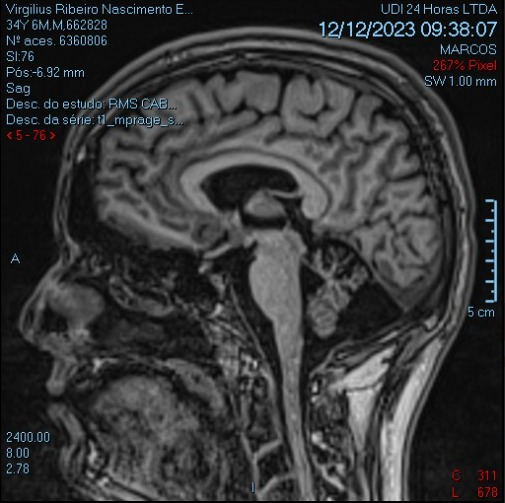Category: Rare Genetic and Metabolic Diseases
Objective: To report the case of an adult male with SLC39A8-CDG and evaluate the effects of manganese supplementation on clinical evolution of the patient.
Background: SLC39A8-CDG is a severe glycosylation disorder (CDG) affecting the manganese (MG) transporter SLC39A8, causing MG deficiency and multisystemic dysfunctions, including severe neurological deficits. It is an extremely rare condition, with only 15 individuals reported in the literature, typically in early childhood. Observational studies suggest that supplementation with MG sulfate and galactose reduces developmental delay. Here, we report a patient undergoing treatment for SLC39A8-CDG, diagnosed in adulthood.
Method: Case Report
Results: A 34-year-old Brazilian male with a 12-year history of progressive ataxic symptoms and childhood psychomotor delays was evaluated. He was initially hypotonic, walked at 5yr and talked at 9yr. Lately, he depicted severe impairment in balance and coordination, and received a diagnosis of autism spectrum disorder (ASD). Physical examination revealed axial and appendicular ataxia, dysmetria, dysarthria, and gaze-evoked nystagmus. Brain MRI (Figure 1) showed cerebellar atrophy and rare hyperintense foci in T2/Flair in the cerebral white matter. The laboratory workup is tabulated in Figures 2 and 3, respectively 1 month before and 9 months after starting treatment. Whole exome sequencing (WES) revealed the SLC39A8 p.(Gly204Cys) likely pathogenic homozygous variant, associated with CDG Type II. Initially, Monohydrated MG Sulfate 10 mg daily was prescribed for 30 days, increasing by 10 mg each month, up to a maximum of 60 mg per day.
Ataxia and cognitive function significantly improved. However, discontinuation of the treatment by the patient’s mother after 1 year into treatment led to a relapse in symptoms: worsening of postural instability, cognitive decline, suicidal ideation, and non-epileptogenic seizures. The patient remained only on Carbamazepine and Levetiracetam. After MG Sulfate reintroduction, antiepileptic drugs replacement by lamotrigine and psychological support, beneficial effects resumed.
Conclusion: MG deficiency associated to SLC39A8-CDG is a rare condition which may be seen in adults. Given that it is a condition amenable to treatment, pursuit via (WES) is warranted in all instances of idiopathic cerebellar ataxia.
(Figure 1)
(Figure 2)
(Figure 4)
(Figure 3)
To cite this abstract in AMA style:
D. Cury Portela, T. Gonçalves Guimarães, G. Sousa Noleto, L. Sousa Araújo, I. Paula, S. Morais, V. Santana Vasconcelos. SLC39A8-CDG with manganese deficiency in an adult individual: a case report [abstract]. Mov Disord. 2024; 39 (suppl 1). https://www.mdsabstracts.org/abstract/slc39a8-cdg-with-manganese-deficiency-in-an-adult-individual-a-case-report/. Accessed April 18, 2025.« Back to 2024 International Congress
MDS Abstracts - https://www.mdsabstracts.org/abstract/slc39a8-cdg-with-manganese-deficiency-in-an-adult-individual-a-case-report/




